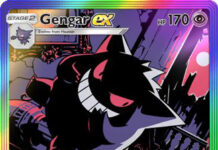A new sub-archetype has pretty much taken the world by storm, especially in the current meta situation. Why it’s a sub-archetype? Because this core can be easily slotted in as its own deck or be placed inside existing archetypes at minimal a cost of overall consistency and it can really help them against the currently popular meta Pokémon. Yes, I’m talking about the Devolution sub-archetype.
But what is this very unique sub-archetype? Well, allow me to explain.
Part 1: The New, but Old Face
First, we need to talk about what is devolution. Simply put, devolution is the process of reversing evolution; as in putting a Stage 2 back into a Stage 1, and a Stage 1 into their basic forms. While the video games surely can’t easily program this type of attacks into their repetoire, the TCG can put in devolution, and it has done so, with its claim of fame… being now.
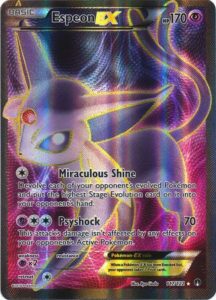
The devolution sub-core actually started off with the release of Espeon-EX (XY BKP) all the way back in early 2016. Its a Psychic type Pokémon-EX with a weakness to Psychic and a 1 retreat cost, which does makes it quite mobile and its main attack also costs 1 energy too, so its good. But what it does, for a single Colorless energy (so you can use it in any deck whatsoever) it devolve(s) all the Pokémon from your opponent’s field with Miraculous Shine by one stage. However, back then the format is ruled by very fast and dangerous basic decks (Night March or Turbo Darkrai-EX) or Mega Pokémon-EX decks (Mega Mewtwo-EX and Mega Gardevoir-EX), which either are unevolved or their basic forms has tremendously high HP that devolving proves difficult and impractical, as they have sky-high HP (170-190 HP) so you’re better off using a normal beat down deck.

But then, the meta has shifted in February of 2017 thanks to the arrival of a new mechanic – Pokémon-GXs. While some of them are still Basic Pokémon which has huge amounts of HP (150-210 currently), most of the more popular ones are evolution Pokémon which, although they have more HP overall (around 200-250) they evolve from dinky 60-70 HP Pokémon. This huge HP spike, which the devolution core had never experience such a meta state before, means that all of a sudden devolution becomes much, MUCH more viable.

In addition, more Pokémon that focused on sniping the bench, or dealing spread damage overall, suddenly arrived in the masses all over the place in just a short period of time. Of great note are these 3 Pokémon; Decidueye-GX with its Feather Arrow ability to snipe 20 damage to any Pokémon in Feb’17, Alolan Ninetales-GX’s Ice Blade which deals 50 to an opposing Pokémon in May’17 and Tapu Koko (SM30, SM31 Promo) which deals 20 damage to all Pokémon with its Flying Flip also in May’17. All of these Pokémon sees high competitive usage (except Decidueye now probably), which paves the way for devolution to be a thing, but more is to come from this sub-core.
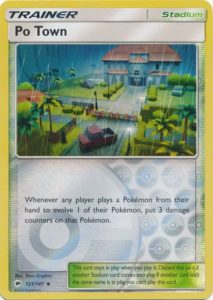
The last piece that ties all this sub-core together came in August of 2017 with the Po Town stadium from SM Burning Shadows. It provides a field condition in which whenever any player evolves a Pokémon, the evolved takes 30 damage. This makes the process of getting the devolving damage much easier, as between the damage from the spreads and Po Town, it becomes much easier for them to deal the 60-80 damage, which is usually the norm, so Espeon-EX (mostly) can come in and start the mass devolution process, which can take multiple prizes.
As in all decks, this sub-core does has its strengths and weaknesses. Its strength lies in the fact that they didn’t need to knock out said Pokémon all the way until they have 0 HP to remove them. They just need to deal enough damage to defeat the Pokémon they evolve from. They are also capable of taking lots of Pokémon out at once, to compensate on their mostly 1 prize take outs per Pokémon.
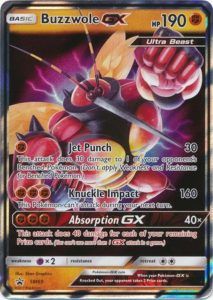
The biggest downside to this strategy is that this sub-core is very deck specific. Although evolution-heavy decks are a thing, there are also Big Basic decks running around such as Lapras-GX (SM Base), Buzzwole-GX (SM CRI) and Volcanion-EX (XY STS) that are purely made of Basic Pokémon. When it does so, then this sub-core becomes pretty much a lost cause. But since this is mostly a deck supplement, this weakness of being utterly dead in some matchups is usually irrelevant.
Part 2: Turbo What Deck?

As said before, this sub-archetype is mostly a deck supplement. Its not meant to be a standalone deck (although you can do that but I didn’t know where will that go) but its something that you placed in as a trap for your opponent, catching them off guard in situations they won’t expect to be in. But what decks benefit the most from this support core?

One of the most common pairings of this devolution sub-strategy is the amazing Psychic core of Drampa-GX/Espeon-GX/Garbodor squad. These 4 pretty much forms one of the best decks currently as they force your opponent to use more resources than they need to, which does help stall time for damage to rack up slowly. Devolution only helps this deck more; as you also play Po Town to help fuel Drampa-GX’s Berserk attack and Tapu Koko, adding in another way to slow your opponents down indiscriminately also forces them to play more resources, which is the goal of the deck itself, fueling Garbodor’s Trashalance in the process. This works really well in countering the meta per se, but it has fallen out a bit in favor thanks to that Zoroark running around.

Another deck that loves devolution as part of their sub-strategy is the famous Golisopod/Garbodor deck. Since this deck is mostly incapable of dealing one shot numbers damage with its normal attack in First Impression, having an extra devolution core helps a lot in its matchups where it is almost impossible to win by brute force, such as Metagross-GX or a well setup Gardevoir-GX deck. By cheating and eliminating them cheekily as you knock out their Basic and Stage 1 forms (as 120 is enough for you to take a Metang or a Kirlia out), you can slow them down and burn their resources more as you continously cycle your Golisopods with Acerola, Super Scoop Up, Float Stones and the like to wear them down alongside Garbotoxin, as you slowly but surely fuel your Garbodor’s Trashalance attack.

And something a little less trash-focused that also loves devolution is the powerful spread and nuker chain deck in the form of Alolan Ninetales-GX/Zoroark-GX/Devolution. Alolan Ninetales-GX snipe power has been explained in the previous part (Part 2), as Ice Blade is amazing to poke ways for devolution alongside Tapu Koko’s Flying Flip. Ice Path GX is also a great tool to punish chip attackers as well. But the more exciting Pokémon here is Zoroark-GX; our main non-Supporter draw power with its Trade ability to discard 1 card and draw 2 per Zoroark, and also the option to attack for good damage with Riotous Beating, dealing up to 120 for 6 Pokémon in play. Does Pokémon loves the number 120 or something, since that’s the normal damage output they usually give to attackers these days? The combination of fast draw support, poking power and chip punishing power does allow Espeon-EX to shine at its finest in this deck, even though it applies a bit less pressure than the Garbodor squad decks.
As you can see here, the main focus of the 3 explained decks are not Espeon-EX and Tapu Koko. Both are just secondary stars in those decks as they both uses Colorless energies, which is why I like to call this a sub-engine; not the main core of a deck, but it supports them massively in their own ways.
Part 3: Cancerous Matching Ups
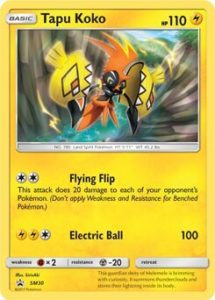
If its worth putting to decks, what does the devolution sub-archetype boost in terms of matchups?
All Stage 2 Decks: 90:10

The main reason why this sub-core becomes very popular; Stage 2 decks are all over the place because they offer much, much better attacks and overall stats at the cost of needing much more support in the early game with stuff like Bridgette and Rare Candy. By devolving them severely and continously, they’ll run out of resources later on because they burn more cards to get their Stage 2s to play, while you keep chipping them down slowly until you reach the point where they cannot retaliate. At that point, the job of the devolution squad is done, and this is where the main attackers come in; deal the big numbers against the practically lower HP Pokémon that they will have left in the field.
All Stage 1 Decks: 70:30

Stage 1 focused decks are a bit more peculiar than the Stage 2s; as they need much less resources to get them to play, they do have many opportunities to rebound from the devolution rather easily. Also the devolution power does vary depending on the deck you faced; some decks has low HP Pokémon as their basic form, but some, like the Silvally-GX cores, has a sky high HP as their basic form (Type: Null has 110 HP, which is very high for an evolving basic Pokémon). The strategy is still the same as the Stage 2 decks, however.
“Big Basic” decks: 0:100

These decks don’t need to evolve to do their stuff, so devolution isn’t going to do anything. Better discard that Espeon-EX away as it’s a dead card against these decks.
Part 4: The Meta Reversal
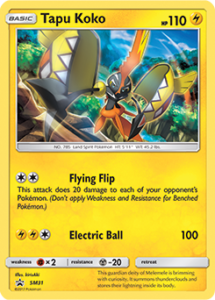
So what can we draw, or conclude, from the explanations given in the previous parts? Surely a conclusion is in order, and here it is.
One of the new trends that fully abuse the meta situation in the season, devolution is truly a strong effect. Having the power to effectively lower the amount of damage needed to get a knockout on a Pokémon, especially the big, bulky Pokémon-GXs, is huge and it does help limit the options of your opponent as they need to constantly recycle their own resources, which takes away momentum quickly and efficiently, and it can tilt the game state in your favor by easily eliminating the biggest potential threats that can evolve. It is also very flexible and can be put theoretically in any deck as they used Colorless energies. But this strategy is a true one-trick-pony; it, as it names implies, it only works on a single archetype classification and is dead in other matchups. But in those matchups, it can really work wonders, and you really should give devolution a try.
So that’s my look at this unique sub-engine to many decks! I believe that devolution now holds an amazing grip in the meta, as it seriously annoys many decks in the format, hindering setup and progress as well as being able to take prizes at the same time.

